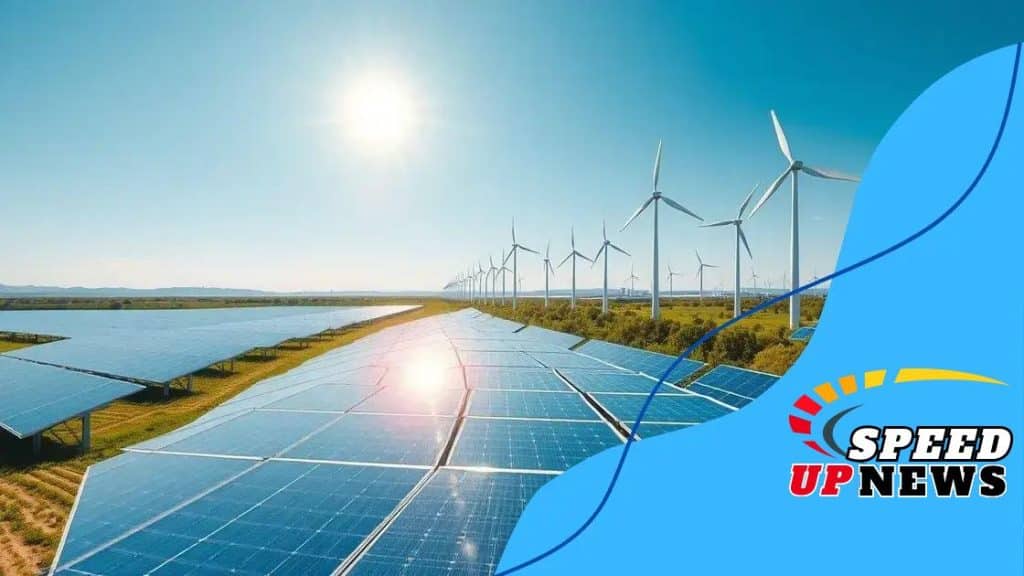Green energy innovations for large-scale projects

Green energy innovations are leading the transformation of energy systems through smart technology, hydrogen fuel, and advanced energy storage, promoting sustainability and reducing reliance on fossil fuels.
Green energy innovations for large-scale projects are reshaping our environment and energy consumption. Have you ever wondered how these advancements impact our daily lives? Let’s dive into the transformative potential they hold.
Understanding green energy innovations
Understanding green energy innovations is crucial for grasping how we can shift towards a more sustainable future. These innovations are not just trends; they represent a significant change in how we produce and consume energy. Let’s explore the key technologies transforming our energy landscape.
What Are Green Energy Innovations?
Green energy innovations refer to new methods and technologies developed to harness renewable energy sources efficiently. This includes advancements in solar power, wind energy, and more. The emphasis is on minimizing environmental impact while maximizing energy efficiency.
Key Technologies Driving Change
Several technologies are leading the way in green energy:
- Solar Panels: Efficient and increasingly affordable, solar panels are capturing sunlight and converting it into electricity for homes and businesses.
- Wind Turbines: Harnessing wind power is one of the most effective methods for producing clean, renewable energy.
- Hydro Energy: This technology uses flowing water to generate electricity, providing a constant and reliable energy source.
These technologies are revolutionizing our power supply and contributing to energy independence. Many countries are now investing heavily in research and development to improve these systems further. For instance, new materials for solar panels are being developed to enhance their efficiency, making solar energy even more viable for widespread use.
Moreover, the integration of smart grid technology allows for efficient energy distribution. This means that energy from various sources can be used more effectively as homes and businesses adapt to changing energy demands.
In addition to these advancements, legislative support and public awareness have surged. Governments are encouraging the use of green technologies through subsidies and incentives, paving the way for a cleaner ecosystem.
The transition to green energy innovations is not merely a possibility but a necessity in combating climate change. By embracing these technologies, we stand to benefit both the environment and our economy.
Key technologies driving large-scale projects
Key technologies driving large-scale projects in green energy innovations are essential to understanding the future of sustainable energy. These technologies not only enhance efficiency but also minimize environmental impact. Let’s explore the main technologies that are shaping large-scale energy projects.
Solar Technology
Solar technology has come a long way in recent years. New solar panels are more efficient than ever, harnessing sunlight to convert it into usable energy. The growth of solar farms is a testament to its importance in large-scale energy projects.
- Photovoltaic Systems: These systems use solar cells to convert light into electricity directly.
- Concentrated Solar Power: This method uses mirrors or lenses to focus sunlight, generating heat that produces energy.
- Solar Battery Storage: Innovations in battery technology allow for storing energy generated during peak sunlight hours for use during the evening or cloudy days.
These advancements boost the reliability of solar energy and promote its integration into the grid. Alongside this, the use of energy-efficient systems continues to rise, allowing for smarter energy consumption.
Wind Energy Innovations
Wind energy is another critical contributor to large-scale green projects. Modern wind turbines are significantly more efficient and can produce energy even in low wind conditions. This technology is evolving rapidly, and innovations are enabling the development of offshore wind farms.
- Vertical Axis Turbines: These turbines can capture wind from any direction, making them versatile for urban environments.
- Turbine Size Innovations: Larger turbines can capture more wind energy, leading to increased energy outputs.
- Smart Wind Farms: Use of AI and IoT technologies helps in monitoring and optimizing wind farm performance.
The flexibility and reliability of wind energy play a vital role in reducing dependence on fossil fuels. As research progresses, the potential for wind energy continues to expand, making it a crucial element in the transition to a sustainable future.
Hydrogen Fuel Technologies
Hydrogen fuel is gaining traction as a clean energy source. Through processes like electrolysis, renewable energy can be used to produce hydrogen, which can then be stored or utilized as a fuel. Its versatility allows for use in various sectors, including transportation and heavy industry.
As these technologies continue to evolve, the capacity for large-scale projects to incorporate hydrogen as a green solution grows. With a focus on innovation, industries are beginning to explore how hydrogen fuel can complement existing energy systems.
The role of government in green energy

The role of government in green energy is crucial for supporting and advancing sustainable practices. Governments worldwide are implementing various policies aimed at promoting renewable energy and reducing reliance on fossil fuels.
Policies and Incentives
Governments create policies that encourage the use of green energy. These include tax credits, grants, and subsidies for individuals and companies that invest in renewable technologies. Such incentives make it financially easier to switch to green alternatives.
- Tax Incentives: Reduced taxes for businesses and homeowners that install solar panels or wind turbines.
- Grants for Research: Funding for research and development helps bring innovative technologies to market.
- Feed-in Tariffs: Encourages energy producers to sell their renewable energy back to the grid, ensuring a steady income.
By putting these policies in place, governments help reduce the financial barriers that often prevent the adoption of green technologies.
Regulatory Frameworks
Another essential role of government is establishing regulatory frameworks that set clear guidelines for green energy projects. These regulations ensure that renewable energy sources are integrated safely and effectively into existing energy systems. For instance, land-use regulations can facilitate the development of wind farms while protecting natural habitats.
Effective regulation leads to streamlined permitting processes and encourages investments in green technology. It also helps to address public concerns about environmental impacts, making communities more receptive to new energy projects.
Furthermore, governments often engage with stakeholders, including businesses, environmental groups, and local communities. This collaboration helps to align interests and ensure that green energy initiatives benefit everyone involved. By actively seeking input and feedback, they can refine policies to better serve the public and the environment.
International Cooperation
On an international level, governments are collaborating to tackle climate change by investing in green technologies and sharing best practices. Through treaties and agreements, such as the Paris Agreement, countries commit to reducing carbon emissions and promoting renewable energy globally.
By working together, nations can achieve ambitious goals much faster than acting alone. This cooperation is vital, as environmental issues do not stop at borders, and addressing them requires comprehensive, coordinated efforts from all governments.
Real-world examples of successful projects
Real-world examples of successful projects in green energy innovations highlight the effectiveness of renewable technologies. These projects illustrate how businesses and governments are implementing sustainable solutions and achieving measurable results.
Solar Energy Successes
One of the most notable examples is the Ivanpah Solar Electric Generating System located in California. This solar thermal power plant became operational in 2014 and uses mirrors to focus sunlight on boilers, generating steam to drive turbines. With a capacity of 392 megawatts, it supplies clean energy to over 140,000 homes annually.
- Key Achievements: Reduced carbon emissions equivalent to taking 70,000 cars off the road.
- Innovative Design: The use of advanced technology to improve energy efficiency and output.
- Community Impact: Created jobs during construction and ongoing operations.
Another impressive project is the installation of solar panels on rooftops in Germany, known for its ambitious renewable energy policy. This initiative has helped the country become a leader in solar energy production, with millions of homes generating their own electricity.
Wind Energy Projects
The Hornsea One project in the United Kingdom stands as a landmark in wind energy. It is currently the largest offshore wind farm in the world, with a capacity of 1.2 gigawatts. This project can power over one million homes and is part of the UK’s strategy to reduce reliance on fossil fuels.
- Achievements: Substantial reduction in carbon footprint through clean energy generation.
- Innovation: Advanced turbine technology maximizing energy capture from wind.
- Local Benefits: Boosted the local economy through job creation and investments.
These successful initiatives showcase how green energy can provide sustainable solutions while also delivering economic benefits. They serve as inspiration for future projects and illustrate the potential of renewable resources in tackling climate change.
Hydrogen Fuel Ventures
In the realm of hydrogen fuel, the H2 Train project in Germany demonstrates innovative applications of this clean energy source. This project focuses on using hydrogen-powered trains to reduce emissions in the transportation sector.
With multiple trains operating successfully since 2018, hydrogen is used as a fuel, promoting a cleaner rail system. This represents a significant step toward more sustainable public transportation options.
Future trends in green energy innovations
Future trends in green energy innovations are vital for understanding how the energy landscape will evolve. As technology continues to advance, we can expect to see significant changes that enhance efficiency and sustainability.
Increased Use of Smart Technology
Smart technology will play a crucial role in the growth of renewable energy. Smart grids are becoming essential for managing energy distribution effectively. They allow for real-time monitoring and adjustments based on energy supply and demand.
- Energy Efficiency: Smart homes can optimize energy use by adjusting lighting and heating automatically.
- Data Analytics: Big data will help in predicting energy consumption trends, aiding in efficient energy management.
- Integration of Renewables: These technologies facilitate the seamless integration of solar, wind, and other renewable sources into the grid.
This integration is essential as we aim to meet the growing electricity demand and transition to cleaner energy sources.
Hydrogen as a Clean Fuel Source
Hydrogen fuel is gaining traction as a future trend in green energy innovations. It can be produced from renewable resources, making it a carbon-free option for various applications.
- Transportation: Hydrogen-powered vehicles are being developed to reduce emissions in the automotive sector.
- Industrial Applications: Hydrogen can replace fossil fuels in manufacturing processes, reducing overall emissions.
- Energy Storage: Hydrogen allows for efficient energy storage, providing backup when renewable sources like solar and wind are unavailable.
This versatility makes hydrogen a key player in the shift towards sustainable energy systems.
Advancements in Energy Storage Solutions
Energy storage technology is critical for maximizing the potential of renewable sources. As more renewable energy comes online, effective storage solutions will be necessary to manage supply and demand.
Innovations like advanced battery technologies and pumped hydro storage are on the rise. These solutions allow for the storage of excess energy generated during peak production times for use later, ensuring a steady energy supply.
With continuous research in energy storage, we can expect improved efficiency and reduced costs, making renewable energy more accessible to everyone.
FAQ – Frequently Asked Questions about Green Energy Innovations
What are the main benefits of green energy technologies?
Green energy technologies reduce carbon emissions, promote sustainability, and improve energy efficiency, leading to a healthier planet.
How can smart technology improve energy management?
Smart technology allows for real-time monitoring and automation of energy use, making it easier to optimize and integrate renewable sources.
What role does hydrogen fuel play in the future of energy?
Hydrogen fuel is emerging as a versatile, clean energy source that can be used across various sectors, including transportation and industry.
Why is community engagement important in renewable energy projects?
Community engagement ensures local needs and concerns are considered in the planning process, fostering support and collaboration for renewable projects.





